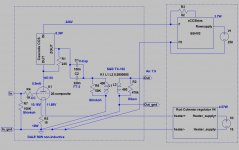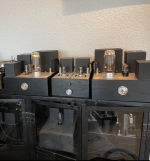Each ancient DH tube microphonic, more or less.
Some type of tube sensitive, but within same type different manufactured tubes can be significantly different.
If you use it with larger signal, the disturbance is more difficult to notice, but it's present.
The line stage is more problematic than few ten Volts driver stage or power stage.
In my #801 preamp the graphite anode ceramic base 801 is ring when I taped the glass, but as power tube it's unnoticeable.
The isolation, decoupling and damping are necessary.
Some type of tube sensitive, but within same type different manufactured tubes can be significantly different.
If you use it with larger signal, the disturbance is more difficult to notice, but it's present.
The line stage is more problematic than few ten Volts driver stage or power stage.
In my #801 preamp the graphite anode ceramic base 801 is ring when I taped the glass, but as power tube it's unnoticeable.
The isolation, decoupling and damping are necessary.
I have some 47. It's not quite as good as the 46 but cheaper. Never tried the 49. I think Ale uses a 49 to drive his 300b if you look at his site. For a gain of just over 4 don't forget the 2a3 or 6B4G or the Svetlana 6C4C which I have a few of and which sounded very nice and dynamic to me as a driver tube if you don't need the gain. I've never had or used a 45.I think I will be keeping the preamp, mainly (but not only) due to the use of the TVC. The 46, 47 and 10Y are driver options too, specially for a 300B output I also want to experiment with. I like the lower filament current demand of the 49, and those others are getting expensive, specially to 10y.
If you use the preamp tube with -nearly- constant/maximized input voltage (when the output signal is large, the disturbances hardly noticeable), must to reduce SF output (for example fixed divider on SF input) to not saturate AVC.BTW, what is your take on using a voltage divider before the SF on the preamp?
Most AVC/TVC tolerate only few Volt signal, before core saturate (at LF).
1P24B triode-connected is a great DHT driver for a 2A3 or 300B in a two-stage amplifier. Has mu of 8. I tried it at 280 V 18 mA with 1:1 bifilar interstage transformer. It was better than 46. The tube has very efficient filament that can ran on NiCd battery, so no need for clumsy filament supply. As a bonus, these tubes are dirt cheap.
Hi Andy, I just bought a pair of AL1, a directly heated pentode. Have you any experience of them? Or are they a bit too new fangled?
I was not aware he is using that one, I must check, last thing I read was he was using his 47 and wanting to try 801a/10y.I have some 47. It's not quite as good as the 46 but cheaper. Never tried the 49. I think Ale uses a 49 to drive his 300b if you look at his site. For a gain of just over 4 don't forget the 2a3 or 6B4G or the Svetlana 6C4C which I have a few of and which sounded very nice and dynamic to me as a driver tube if you don't need the gain. I've never had or used a 45.
If you use the preamp tube with -nearly- constant/maximized input voltage (when the output signal is large, the disturbances hardly noticeable), must to reduce SF output (for example fixed divider on SF input) to not saturate AVC.
Most AVC/TVC tolerate only few Volt signal, before core saturate (at LF).
Yes, I should have around less than 8 Vrms, which should be ok (according to the AVC specs). My question was really aimed at your take on the penalty in transparency as a consequence of the resistors (divider). I have used the 01a without it and w/o AVC. Ale Moglia does advise to use the best resistors possible (of course!): "I will not repeat and say it only once. put the best quality resistor in R5 you can find. That’s my only advice as the impact on sound is significant."
Yes, it's the 47 or 247 globe in his case. I just have ST shape which wasn't as good as the 46.I was not aware he is using that one, I must check, last thing I read was he was using his 47 and wanting to try 801a/10y.
If the 1P24B were as good as a 46 that would surprise me a lot! Should I buy some and try it?
Don't know the AL1.
I attach my #26 preamp schematic (built a decade ago).My question was really aimed at your take on the penalty in transparency as a consequence of the resistors (divider). I have used the 01a without it and w/o AVC. Ale Moglia does advise to use the best resistors possible (of course!): "I will not repeat and say it only once. put the best quality resistor in R5 you can find. That’s my only advice as the impact on sound is significant."

As you can see, it's -almost- "cost no object" version for critical components (my daily used #801 preamp use similar -costly- parts).
If you want to build good, reliable tone audio equipment, the -final- components would be smaller part of the overall cost: designing, building, testing, measuring, iteration, iteration, iteration .... and -maybe- final state.
Sure. they are less than $2 apiece, and Ukrainian post still works fine. I just received a package from Ukraine, took less than 2 weeks.If the 1P24B were as good as a 46 that would surprise me a lot! Should I buy some and try it?
There are some data sheets that rate plate power at 2.5 W. But I have Russian data sheet showing 4 W plate and 1.5 W screen. I believe 2.5 W is for use in tight enclosures, like in aerospace equipment and missiles.
There is an AVC that will tolerate some DC and can be connected directly (without capacitor) to CD player output op-amp. It is Atlas Sound AT-10 line-level volume control. Not fancy, only 10 steps, but as transparent as they get. Slagle or Silk TVC are intolerant of DC.
Another solution is to use input transformer with DC capability, such as UTC O-26, in front of the Slagleformer.
Another solution is to use input transformer with DC capability, such as UTC O-26, in front of the Slagleformer.
I read in another post that you found the 3D6 more refined sounding. Is that so? How does 3D6 compare with 2P29L, which I know well?Sure. they are less than $2 apiece, and Ukrainian post still works fine. I just received a package from Ukraine, took less than 2 weeks.
There are some data sheets that rate plate power at 2.5 W. But I have Russian data sheet showing 4 W plate and 1.5 W screen. I believe 2.5 W is for use in tight enclosures, like in aerospace equipment and missiles.
That was in a different circuit - a PP headphone amplifier. I like the sound of 3D6. Never tried 2P29L, so cannot compare. 1P24B is particularly suitable as DHT driver because it can be used at high plate voltage, an important consideration for low distortion at high output swing. For 3D6 triode-connected, maximum plate voltage is 150 V; 1P24B can take 300 V.I read in another post that you found the 3D6 more refined sounding. Is that so? How does 3D6 compare with 2P29L, which I know well?
Not that this is terribly important, but instead of confusing someone I want correct myself and say that he was writing about the cathode resistor (R5), not the resistors for the divider. I was thinking about them (the needed quality and impact of those) while reading his post.🙄Ale Moglia does advise to use the best resistors possible (of course!): "I will not repeat and say it only once. put the best quality resistor in R5 you can find. That’s my only advice as the impact on sound is significant."
Thank you for sharing that. I see your attention to several resistors there, I have never really known which are more critical.I attach my #26 preamp schematic (built a decade ago).
Tried 1p24b 260v / 15 mA triode connected fixed bias but 4 out of 6 showed thermal runaway, didn't stop increasing current; don' t know whether or when they'd have melted down. Had to cut back to 9 mA; anything over 2.5 W was unstable;... tried it at 280 V 18 mA with 1:1 bifilar interstage transformer. It was better than 46. The tube has very efficient filament that can ran on NiCd battery ...
maybe not with battery heaters and cathode bias ...?
Cathode bias should be more stable than fixed bias.1p24b 260v / 15 mA triode connected fixed bias but 4 out of 6 showed thermal runaway, didn't stop increasing current;
But first, what is the value of your grid leak resistor? Try using 100kΩ; measure the voltage across this 100k, to see if the grid is leaking current. If you get more than 0.3V (Ua = 260V), the valve may be gassy, and this will make runaway much more likely. That's quite often found with unused valves, >20 years old; if it's all-glass envelope, you can bake them for a while to reduce the gas.
It looks super. The "Stove" style of the transformer enclosures is tough and impressive too. I need to get a new welding set!
I used 1P24B at 5 W dissipation for many hours, and there wasn't thermal runaway. g2, g3 and internal screen tied to plate. Fixed bias from battery, g1 circuit resistance 65 Ohms (input transformer). Tubes mounted vertically on prototyping boards for free air circulation, like this:

Here is part of 1P24B data sheet with maximum Pa and Pg2 circled:

Here is part of 1P24B data sheet with maximum Pa and Pg2 circled:
hmm, maybe its because of your very low g1 resistance ...
I have between 150k and 250k depending on the position of the bias pots;
vertically free standing tubes as well.
I have between 150k and 250k depending on the position of the bias pots;
vertically free standing tubes as well.
- Home
- Amplifiers
- Tubes / Valves
- All-DHT amplifiers: no indirectly heated signal tubes!
